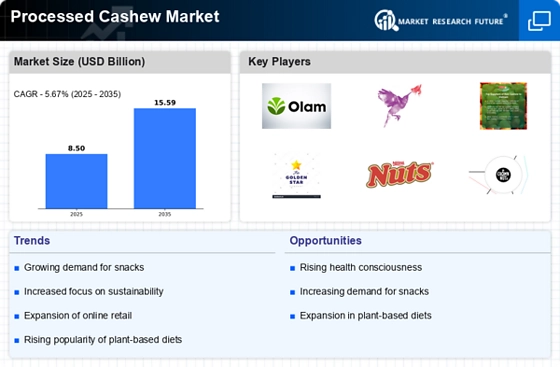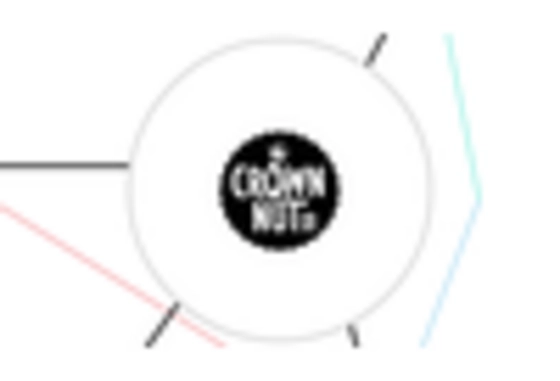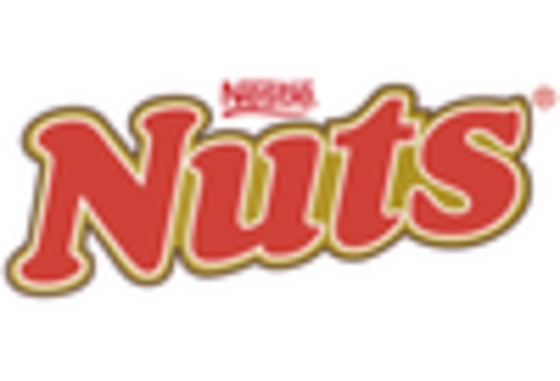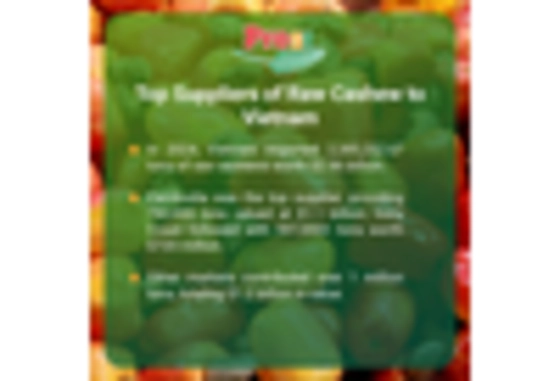Rising Snack Consumption
The increasing trend of snacking, particularly among younger demographics, appears to be a significant driver for the Processed Cashew Market. As consumers seek healthier alternatives to traditional snacks, processed cashews are gaining popularity due to their nutritional benefits, including high protein and healthy fat content. Market data indicates that the snack food segment is projected to grow at a compound annual growth rate of approximately 5.5% over the next five years. This growth is likely to bolster the demand for processed cashews, as they are often marketed as a convenient and nutritious option. Furthermore, the versatility of processed cashews in various snack forms, such as roasted, flavored, or as part of trail mixes, enhances their appeal. Thus, the rising snack consumption trend is expected to continue driving growth in the Processed Cashew Market.
Sustainability Initiatives
Sustainability initiatives are becoming increasingly important in the Processed Cashew Market, as consumers are more inclined to support brands that prioritize ethical sourcing and environmentally friendly practices. The demand for sustainably sourced cashews is rising, driven by consumer awareness of the environmental impact of food production. Companies that adopt sustainable practices, such as fair trade certification and eco-friendly packaging, are likely to gain a competitive edge. Market data indicates that products marketed as sustainable can command a premium price, reflecting consumer willingness to pay more for ethically produced goods. As sustainability continues to shape consumer choices, the Processed Cashew Market may see a shift towards more responsible sourcing and production methods.
Innovative Product Development
Innovation in product development is a crucial driver for the Processed Cashew Market. Manufacturers are increasingly introducing new flavors, packaging formats, and value-added products to cater to evolving consumer preferences. For instance, the introduction of flavored cashews, such as spicy or sweet varieties, is attracting a diverse consumer base. Additionally, the trend towards organic and non-GMO products is prompting manufacturers to adapt their offerings accordingly. Market data suggests that the organic snack segment is growing at a rate of 8% annually, indicating a strong consumer preference for healthier options. This focus on innovation not only enhances product appeal but also allows companies within the Processed Cashew Market to differentiate themselves in a competitive landscape.
Expansion of E-commerce Platforms
The rapid expansion of e-commerce platforms is transforming the retail landscape and significantly impacting the Processed Cashew Market. With more consumers turning to online shopping for convenience, the availability of processed cashew products through various e-commerce channels is increasing. Market data indicates that online sales of food products are expected to grow at a rate of 10% annually, driven by the rising preference for home delivery and the ease of access to diverse product offerings. This shift towards online purchasing is likely to enhance the visibility and accessibility of processed cashew products, allowing manufacturers to reach a wider audience. Consequently, the Processed Cashew Market may experience substantial growth as e-commerce continues to reshape consumer buying habits.
Increased Awareness of Nutritional Benefits
The heightened awareness regarding the health benefits of nuts, particularly cashews, is influencing consumer preferences and driving the Processed Cashew Market. Cashews are recognized for their rich nutrient profile, including essential vitamins, minerals, and antioxidants. Recent studies suggest that regular consumption of cashews may contribute to improved heart health and weight management. This growing awareness is reflected in market data, which shows that the demand for healthy snacks has surged, with nuts being a preferred choice among health-conscious consumers. As more individuals prioritize their dietary choices, the processed cashew segment is likely to experience increased sales. The Processed Cashew Market stands to benefit from this trend, as manufacturers are increasingly promoting the health attributes of their products to attract a broader consumer base.


















Leave a Comment